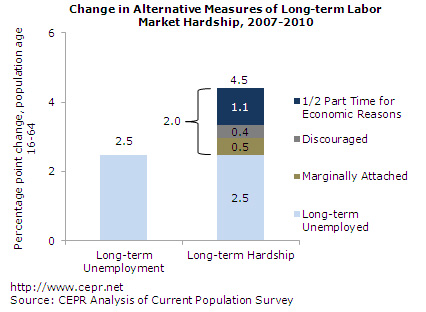January 2012, John Schmitt and Janelle Jones
From peak to trough, the United States lost almost nine million jobs in the most recent economic downturn. What was completely unprecedented about the most recent recession, however, was the explosion in long-term unemployment. The depth and length of the recession pushed the long-term unemployment rate – the share of unemployed workers who have been unemployed for 27 weeks or longer – to over 40 percent throughout the entirety of 2010 and 2011. The official concept of “long-term unemployment,” however, is incomplete and, in some cases, even potentially misleading. As tracked by government statistics, the long-term unemployed are only a relatively small part of the population facing extended, sometimes permanent, spells without work.
This paper proposes rethinking our understanding of long-term unemployment in two ways. First, we encourage shifting from a narrow focus on long-term unemployment toward a broader concept of “long-term hardship” in the labor market. Many workers or potential workers who do not fit the official definition of long-term unemployment – including “discouraged” and “marginally attached” workers and those involuntarily working part-time jobs – face long-term hardship in the labor market, but are not captured in the standard measure of long-term unemployment.
Second, we suggest complementing the standard measure of long-term unemployment, which reports the share of the unemployed who have been out of work for six months or more, with an alternative measure, which reports the share of the total labor force that has been unemployed for six months or more. This alternative measure avoids some counter-intuitive properties of the standard statistic and is better for making comparisons across demographic groups.

